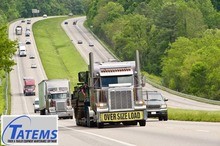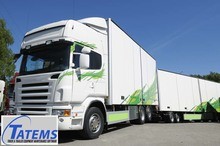Paccar Parts Introduces Charging Stations for All Electric Vehicles

Paccar Parts is anticipating the global launch of electric vehicles by revealing new charging stations. They are releasing multiple fast chargers that are rated up to 920V DC. Chris Scheel says that they offer a range of products that range from 20 KW to 350 KW. They anticipate that their chargers will get a truck up to full battery in around four hours. They are compact is size which is nice for the urban market.
Key Takeaways:
- Early in 2021 Paccar Parts has proudly lifted the veil on a stunning institution, the creation of new electrical charging stations.
- This successful launch on the part of Paccar Parts is meant to synch with the global launch of electrical vehicles world-wide.
- The station is designed to work with an array of vehicle types and brands, including Kenworth, Peterbilt and DAF electric.
“The 20 kW charger option is a UL-certified DC Wallbox and the perfect charger for commercial parking and fleet or dealership service facilities. The low power DC charger is easy to install and ideal for vehicles with extended dwell times.”
Santa Monica Seafood Delivers

The Santa Monica Seafood Company is a high profile distributer, as it is the largest specialty seafood distributer of fresh and frozen seafood in the U.S. Southwestern region. The company has earned it valid and well-regarded reputation in the industry by making timely deliveries a core commitment. The trucks are also regulated to deliver the contents at the right temperature. Across the region in which it operates the company has about 80 trucks. of which almost 90% are medium duty and of a class 3-8 box style vehicle. The eclectic fleet has an array of models, including Peterbilt, Kenworth and Freightliner models. The 10% of the fleet that is not allocated as medium duty are heavy duty vehicles, including 53 foot tractor-trailer models. A typical service stop includes about 10 cases. Generally routes are considered dense, that is consisting of more than a dozen stops to finish the route. Destinations include hospitals, groceries, military bases and even theme parks. Going forward, a big concern for the company, instituted in 1939 is acquiring up-to-date and relevant technology for its mostly medium-duty trucks, as its been historically the precedent to offer the most cutting edge advantages to the heavier truck models first.
Key Takeaways:
- At the top of the heap size-wise, as regards fresh seafood distribution, is Santa Monica Seafood Company, at least so far as the Southwest region is concerned.
- The landlocked Southwest loves its seafood, and SMS delivers the goods in a timely manner, packed at the proper cold temperatures.
- The SMS food delivery fleet consists of about 80 medium-duty sized trucks and class 3-6 box style vehicles.
“Most trucks drive dense delivery routes (15-35 stops per route) for foodservice customers — restaurants, hotels, grocery stores, hospitals, event venues, casinos, country clubs, military bases, and theme parks (e.g., Disneyland).”
Read more: https://www.truckinginfo.com/10133346/santa-monica-seafood-delivers
Electric Last Mile Solutions is Bringing Electrification to E-Commerce Delivery

Electric Last Mile Solutions is a new electric van start up that wants to shake up the industry to be more sustainable. Their new van is set to be released by the third quarter of 2021. It's set to be made for rural deliveries where the van only has to rely on it's 150 mile range. The van will be able to charge completely in two hours and should make last stop trips truly sustainable.
Key Takeaways:
- Electric Last Mile Solutions is a new startup that focuses on electric delivery vehicles.
- ELMS is building vans that are made for the final step in delivery for urban markets.
- ELMS plans to have their first product released in the third quarter of 2021 with the goal of the van being able to charge in two hours.
“With the launch the company is also ensuring that it is developing a product aimed at giving fleets a low total cost of ownership (TCO), an essential component to what every fleet manager looks for in vehicles it acquires.”
Imagining a Completely Driverless Truck

Self-driven vehicles are in our future, and we’ve seen the technology improving in the recent years. Yet, when we envision the driverless cars, few of us actually thinks of trucks without drivers. While autonomous truck prototypes are already presented to the general public, we can imagine and take this step further imagining a truck that is completely automated. Such truck would not have a cab, infotainment or stereo systems. Drive data would be transmitted remotely to a control center, where all monitoring would be done.
Key Takeaways:
- Although the idea of a driverless truck has been on the radar for a while, a true design for one is non-existent. Currently, there are only models that include some experimental autonomous controls.
- Such a vehicle would be very stripped down, as human needs would be a non-issue. Gone would be anything having to do with human comfort. or entertainment. No cup holders.
- What would probably remain would be the electronic capability and the temperature parameters to accommodate the product being hauled.
“In addition, the truck cab has to be arranged in a way to serve as a home away from home for long-haul drivers. All of that stuff – and all of that space and weight and materials – would suddenly be superfluous for an autonomous truck designer.”
Read more: https://www.truckinginfo.com/10133617/imagining-a-completely-driverless-truck
How Old Is Your Diesel Exhaust Fluid?

Due to the worldwide Covid-19 pandemic many companies have had to change their way of conducting business. Venues and events have had to be cancelled. Routes have changed. Straitened means has resulted moreover in some cutting of costs. Because of this some vehicles that may have been seeing regular use before the pandemic may have gotten sidelined. As things improve and the economy slowly reverses from its danker and darker regions some companies are bringing sidelined vehicles back into active duty. While this is a hopeful sign, it is very important not to rush it. Vehicles that have been out of commission for a time must be overhauled very thoroughly before getting back on the road. Many components should go into an exhaustive checklist to ensure these vehicles are road-worthy, including a step that can be overlooked. It's very important to check the diesel exhaust fluid in these vehicles. Under the best of conditions, data shows that such fluid should remain in these service vehicles for no more than 12 months. The time period can be altered considerably if the vehicle has been subject to summer heat temperatures, or there exists the real possibility of contamination. Autobus, truck and motor-coach fleet owners are well-advised to ensure that any diesel fluid purchased should be of ISO standard quality and kept at the optimal temperature and dispensed from a DEF appropriate container. Never use any equipment that has been used for other motor vehicle fluids. Moreover, such equipment should be kept clean with distilled or de-ionized water. Another concern that managers and owners should be on top of is when the fluid freezes in the vehicle. It's important not to pour in additives. Such additives will mar the product purity. Rather, allow the fluid to warm and thaw on its own, which it normally will.
Key Takeaways:
- Before vehicles can be brought back into active fleet service an exhaustive list of checks should be completed, including potentially replacing outdated Diesel Exhaust Fluid.
- Many vehicles have been sidelined due to logistical changes brought about by the pandemic. These include autobuses, trucks and motor-coaches.
- Besides simply being too old, DEF fluid can become contaminated or be affected by the extremes of summer heat.
“The American Petroleum Institute recommends that you determine when DEF was put in the vehicle. The storage life of DEF is about 12 months in optimal conditions. If DEF has been stored in the vehicle over the past 12 months, it is recommended that it be drained and replaced.”
Read more: https://www.truckinginfo.com/10134704/how-old-is-your-diesel-exhaust-fluid
Advances in Trucking Fleet Management Make Life Easier

Advances in Trucking Fleet Management Make Life Easier
A number of different trends in trucking fleet management are coming together to make hauls more efficient and enjoyable. Software can now provide load- and truck-specific routes that cut down on drive times. That leaves more time for you and your family. What's also nice is that current trends like “bring your own device” (BYOD) are getting incorporated into trucking fleet management to make your routes easier to plan and navigate. The upshot is greater efficiency and more free time to do what you love.
Bring Your Own Device (BYOD)
Any modern device that runs on Android, Google's operating system, or iOS, Apple's operating system, will do as a BYOD device. As long as you bring along your smartphone, iPad, or Apple Watch, you should have access to thousands of trucking apps. By bringing your own device on the job you will have access to a number of helpful apps, including those that cover: navigation, load compliance, weigh stations, and possible vehicle inspections. For companies, BYOD policies can lead to reduced hardware costs, training expenses, and annoying software licensing fees.
Better Telematics
Telematics is the branch of information science that covers the sending and receiving of information, potentially across long distances. Sensors are the glue that makes better telematics possible in the trucking industry. Better sensors can tell fleet maintenance managers when a truck needs repair or some kind of adjustment to bring its performance up to a certain standard. As a trucker, you will receive a much richer picture of the current performance of your rig, and fleet maintenance managers will be clued into upcoming repairs. Updates on potential problems can inform overall fleet management (e.g., by indicating a truck needs to be taken out of commission).
Load- and Truck-specific Routes
Getting to the next waypoint on time can be stressful enough without worrying about the literal stress of 75,000 pounds of truck and material not being able to make the journey. The end goal shared by all truckers is getting to the next waypoint efficiently, safely, and ahead of schedule. Truck navigation software is already used by hundreds of thousands of truckers around the country, and the reach of this innovative navigation software is becoming global in scope. Trucking navigation software can enable you to:
- Receive customized messages based on trucking location
- Locate trade routes (not a feature of every navigation system!)
- Locate POI, e.g., safe and reliable overnight parking
- Locate constantly updated road closures and reroutes
- Ensure right-side approach for easier, safer pull-ins
Today's navigation software can factor in the size of your route and the foregoing kinds of data so that your ride is smoother, safer, and more enjoyable.
Solutions Working Together to Improve Fleet Management
Many of the solutions discussed above work synergistically to improve fleet management. For instance, bringing your own device to work will enable better telematics and access to helpful suggestions in terms of load- and truck-specific routes for your next haul. Why wouldn't you want to use these technologies?
The Top Safety Tips For Truck Drivers

When navigating the roads, it’s prudent to expect the unexpected. This advice is especially important for truck drivers to heed. With considerable caution and on-the-road safety tricks, you can ensure that you remain out of harm’s way while en route. Whether you’re preparing for a trip or traveling to your destination, here are some tips to consider while in the driver’s seat.
Pre-Road Safety Hacks
Track The Weather
When bad weather rears its ugly head, driving becomes exponentially more dangerous. According to the Federal Highway Administration, nearly 21 percent of vehicle crashes are weather-related. With that said, it’s critical to check the weather both before you’re driving and while on the road.
Get Comfortable
There’s nothing more bothersome than being uncomfortable in the driver’s seat. Fidgeting and constantly adjusting will only distract from what’s going on on the road. To keep yourself cozy and attentive, find your sweet spot before the trip begins.
On-The-Road Safety Hacks
Stay Alert
It’s all too easy to get distracted while driving. If you feel your concentration waning, take a break. As a result, you’ll give yourself the opportunity to refuel. Much like your truck, you don’t perform as well when you’re running on empty. To avoid an accident, it’s crucial to stay alert while behind the wheel.
Stay In Your Lane
Due to their large size, trucks are sensitive to wind, speeding cars, and other unpredictable elements. When these forces are too strong, it can cause you to swerve into the next lane. By keeping both hands on the wheel, you remain in complete control of the vehicle and, in turn, manage to stay in your lane.
Maintain Distance
If you have to come to a screeching halt, you’ll need about seven seconds to do so. With that in mind, keep a reasonable distance between you and the car ahead of you. When you do have to come to a stop, you’ll find comfort in knowing that you won’t plow into the vehicle in front of you.
Truck Maintenance Basics For Drivers

Repairs on the Road
Every seasoned trucker knows the feeling of coasting down the open road only to hear an unsettling screech, thump or bump radiating from the front end of the vehicle. Repairs are a part of trucking life and we have to decide right on the spot whether it is within our scope of knowledge, or if an outside contractor must be sent in to address the issue at hand. These types of decisions have to be made in the moment and as on the road trucking fleet operators, we have to prepare ourselves with the knowledge base necessary to make these types of decisions. There are several different common repairs that truckers have to address. There are those repairs that can be overlooked by the trucking fleet ownership and the trucking fleet operator must address them on the spot due to a lack of due diligence. These include oil changes and oil leaks. There are also routine repairs that must be made regardless of the ownership's upkeep of the vehicle, such as tire changes and battery jumps.
Oil Changes
All semi-trucks must undergo frequent oil changes. How often the truck will require oil changes depends upon many factors. If the truck is climbing steep terrain frequently, then it will require a frequent oil change. It also depends upon how many miles the truck travels in a period of time. The more miles on the vehicle, the more frequently the truck will require an oil change. As truck operators, we know that diesel engines require oil changes just like gasoline engines do.
Oil Leaks
Another issue that may arise on the road is an oil leak within the engine. Oil leaks must be addressed by experienced mechanics. If the truck operator happens to have a background in engine mechanics, by all means, he can perform the repair. However, more likely than not, the truck driver will have to call upon the help of a seasoned semi-truck engine mechanic. This can require being off the road for a longer amount of time than expected in order to allow for repair time for the vehicle. Oil leaks are indicated by a consistently low oil level gauge even when the oil has just recently been refilled in the engine.
Tire Changes
Routine tire changes must be made on the semi-truck vehicle. As semi-trucks frequently travel through rough terrain, worn roads, icy conditions, and generally hazardous environments, it is important to keep up a good thick tread on the tires. The tread on semi-truck tires gets worn down more quickly than on a standard vehicle both because of the extreme nature of the terrain and also because of the sheer amount of mileage being put on the tires. A seasoned semi-truck driver should become familiar with how to properly remove and install tires.
Battery
The life of a battery is very important when it comes to trucking because few vehicles that could stop alongside the road to help with a jumpstart would have battery power strong enough to jumpstart a semi-truck engine. It is important for the driver to consistently monitor battery life so that he never ends up in such a situation.
7 Car Damaging Habits That Are Hurting Your Car

There are seven things that are commonly done to vehicles that can cause a lot of damage in the long and short run. If you are driving your car recklessly, then you are not only putting your car at risk, but you are putting yourself at risk as well. If you accelerate after braking, or if you drive quickly, you are both burning up gas and wreaking havoc on your transmission. You should also never ignore the warning lights on the dash board.
Key Takeaways:
- While we might know that maintenance is necessary, we might not know the repercussions.
- The faster you drive, the more fuel you use and the more pressure you are putting on the transmission.
- If you are ignoring the lights or ignoring regular maintenance, this could lead to damages.
“Before riding on the streets of the UAE, it is advised that you go through the several stringent road safety laws and regulations implemented by the regulatory authorities.”
Read more: https://www.carcility.com/blog/7-car-damaging-habits-that-are-hurting-your-car/
Alloy Wheels Vs Steel Wheels: Which Is Better

Wheels made from allow or steel are two most common wheel types and customers often pose the question regarding the difference between the two. Steel wheels are the basic type going back to automotive beginnings. There are many metals that can be used in allow wheel manufacturing process, but aluminum alloys are most widely used. Wheels made of steel are generally cheaper, more durable, but are heavier, which may not be preferable, depending on the use of the wheel.
Key Takeaways:
- Alloy wheels and steel wheels are two wheels that are wanted and each have different conditions.
- Each one has different features and it will depend on what you want out of a tire, like durability and pricing.
- The weight of the steel wheels is beneficial for situations where you might be in the snow.
“The centrepiece wheel (with specific design for hub and spokes) and rim are separately made and then welded into one piece, followed by the final polishing and coating for the glossy finish.”
Read more: https://www.carcility.com/blog/alloy-wheels-vs-steel-wheels/


